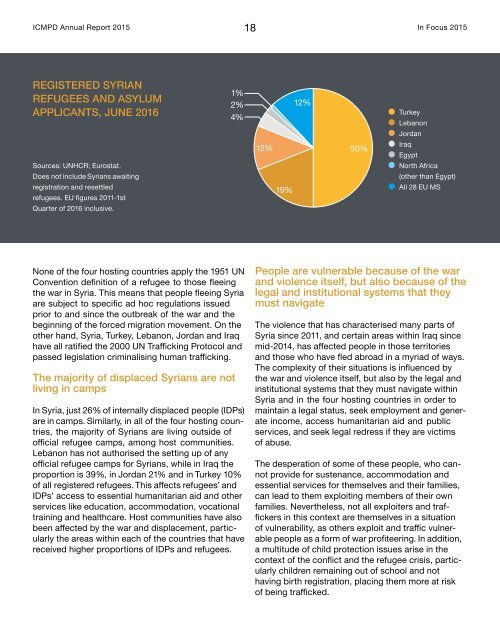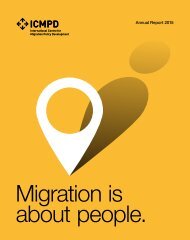ICMPD-Review-2015
You also want an ePaper? Increase the reach of your titles
YUMPU automatically turns print PDFs into web optimized ePapers that Google loves.
<strong>ICMPD</strong> Annual Report <strong>2015</strong><br />
18<br />
In Focus <strong>2015</strong><br />
REGISTERED SYRIAN<br />
REFUGEES AND ASYLUM<br />
APPLICANTS, JUNE 2016<br />
Sources: UNHCR; Eurostat.<br />
Does not include Syrians awaiting<br />
registration and resettled<br />
refugees. EU figures 2011-1st<br />
Quarter of 2016 inclusive.<br />
1%<br />
2%<br />
4%<br />
12%<br />
19%<br />
12%<br />
50%<br />
Turkey<br />
Lebanon<br />
Jordan<br />
Iraq<br />
Egypt<br />
North Africa<br />
(other than Egypt)<br />
All 28 EU MS<br />
None of the four hosting countries apply the 1951 UN<br />
Convention definition of a refugee to those fleeing<br />
the war in Syria. This means that people fleeing Syria<br />
are subject to specific ad hoc regulations issued<br />
prior to and since the outbreak of the war and the<br />
beginning of the forced migration movement. On the<br />
other hand, Syria, Turkey, Lebanon, Jordan and Iraq<br />
have all ratified the 2000 UN Trafficking Protocol and<br />
passed legislation criminalising human trafficking.<br />
The majority of displaced Syrians are not<br />
living in camps<br />
In Syria, just 26% of internally displaced people (IDPs)<br />
are in camps. Similarly, in all of the four hosting countries,<br />
the majority of Syrians are living outside of<br />
official refugee camps, among host communities.<br />
Lebanon has not authorised the setting up of any<br />
official refugee camps for Syrians, while in Iraq the<br />
proportion is 39%, in Jordan 21% and in Turkey 10%<br />
of all registered refugees. This affects refugees’ and<br />
IDPs’ access to essential humanitarian aid and other<br />
services like education, accommodation, vocational<br />
training and healthcare. Host communities have also<br />
been affected by the war and displacement, particularly<br />
the areas within each of the countries that have<br />
received higher proportions of IDPs and refugees.<br />
People are vulnerable because of the war<br />
and violence itself, but also because of the<br />
legal and institutional systems that they<br />
must navigate<br />
The violence that has characterised many parts of<br />
Syria since 2011, and certain areas within Iraq since<br />
mid-2014, has affected people in those territories<br />
and those who have fled abroad in a myriad of ways.<br />
The complexity of their situations is influenced by<br />
the war and violence itself, but also by the legal and<br />
institutional systems that they must navigate within<br />
Syria and in the four hosting countries in order to<br />
maintain a legal status, seek employment and generate<br />
income, access humanitarian aid and public<br />
services, and seek legal redress if they are victims<br />
of abuse.<br />
The desperation of some of these people, who cannot<br />
provide for sustenance, accommodation and<br />
essential services for themselves and their families,<br />
can lead to them exploiting members of their own<br />
families. Nevertheless, not all exploiters and traffickers<br />
in this context are themselves in a situation<br />
of vulnerability, as others exploit and traffic vulnerable<br />
people as a form of war profiteering. In addition,<br />
a multitude of child protection issues arise in the<br />
context of the conflict and the refugee crisis, particularly<br />
children remaining out of school and not<br />
having birth registration, placing them more at risk<br />
of being trafficked.
















